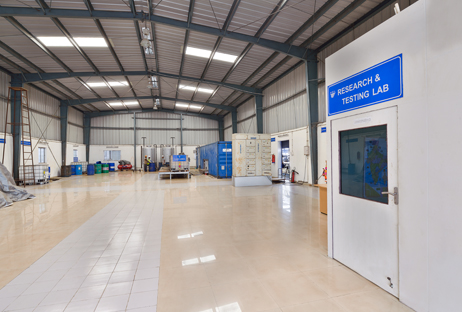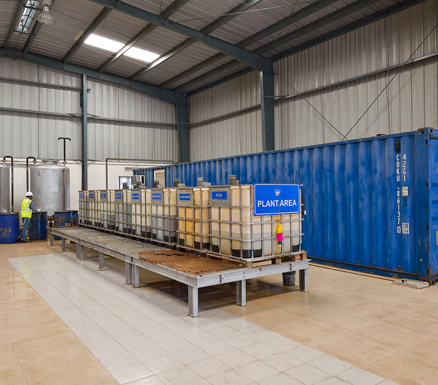Bitumen Emulsion is one of the main ingredients used in road construction and maintenance. It is a two-phase system consisting of bitumen, water and one or more additives (Emulsifiers). Bitumen is dispersed throughout the water phase in the form of discrete globules typically in the range of of 0.1 to 10 micron in size, which are held in suspension in water and prevented from flocculating and settling by emulsifier charges. The emulsifier plays an important role to keep the bitumen droplets in a stable suspension, control breaking time and aids adhesion also.
Bitumen Emulsion typically contains 50-75% bitumen, o.1-2% emulsifying agent and rest water. These components are introduced into a colloid mill that operates at a very high speed motor (1000-6000rpm) which shears bitumen emulsion into tiny globules. Variable Rotor Stator Gap in Colloid mill controls bitumen material. The size of globules that in turn controls the viscosity of bitumen emulsion. We are quality Bitumen Emulsion manufacturers and exporter in all over India.


Bitumen Emulsion are classified on the basis of Electrical charge. Emulsifier envelops itself on the bitumen droplet and provides electrical charge on surface of bitumen globules preventing them to coalesce.
ANIONIC
It is the first category of emulsion that was engineered for road construction. Due to their negative globules, they are less efficient than other two i.e. Cationic or Non-ionic. Suitable for Calcareous aggregate like lime stone, dolomite etc.
NON-IONIC
Rarely used in road construction.
CATIONIC
Due to their positive charge, the emulsion coats the aggregate efficiently and flaunts effective adhesion attributes. Cationic Emulsion also wakes as an anti-stripping agents so highly favorable in construction industry and hence ismost widely used. Such emulsions are most suitable for siliceous aggregate like quartzite, sand stone, granite, etc.
On the basis of how quickly the emulsion reverts to bitumen, cationic bitumen emulsions are divided into Rapid setting, Medium setting and Slow setting emulsion. Further classified as per IS: 8887-2004 into RS-1, RS-2, MS, SS-1 and SS-2.
RAPID SETTING-1(RS-1)
Used for Tack Coat Applications
RAPID SETTING-2(RS-2)
Used for Surface dressing
MEDIUM SETTING (MS)
Used for Open graded premix for coarse
SLOW SETTING (SS-1)
Used for Prime coat application or for sealing cracks and fog seal
SLOW SETTING (SS-2)
Used for slurry seal, seal coat (premix with large fine aggregate content
| BITUMEN EMULSION (CATIONIC TYPE) – SPECIFICATION | |||||||
| Parameter of Bitumen Emulsions | CODE | ||||||
| S.No. | Characteristic | SS – 1 | RS – 1 | SS – 2 / Slurry Seal | Microsurfacing (IRC:SP 81-2008) | CSS-1h (ASTM D 2397-02) | |
| 1. | Residue on 600 microns, % by mass max.(Sieve Test). | 0.05 | 0.05 | 0.05 | 0.05 | 0.1 | IS 8887-2004 |
| 2. | Viscosity by saybolt Furol viscometer, seconds. | IS 8887-2004 | |||||
| at 25°C | 20-100 | – | 30-150 | 20-100 | – | – | |
| at 25°C SFS | – | – | – | – | 20-100 | – | |
| at 50°C | – | 20-100 | – | – | – | – | |
| 3. | Coagulation of emulsion at low temperature. | NIL | NIL | NIL | NIL | NIL | IS 8887-2004 |
| 4. | Storage stability after 24 hours, % Max. | 2% | 2% | 2% | 2% | 1% | IS 8887-2004 |
| 5. | Particle Charge. | Weak Positive | Positive | Positive | Positive | Positive | IS 8887-2004 |
| 6. | Stability to mixing with cement (% coagulation), Max. | 2 | – | 2 | – | 2 | IS 8887-2004 |
| 7. | Miscibility with water. | – | No Coagulation | No Coagulation | – | – | IS 8887-2004 |
| 8. | Residue by evoperation, % Min. | 50 | 60 | 60 | 60 | 57 | IS 8887-2004 |
| 9. | Penetration 25°C / 100 g / 5 Sec. | 60-350 | 80-150 | 60-120 | 40-100 | 40-90 | IS 8887-2004 |
| 10. | Ductility 27°C / cm, Min. | 50 | 50 | 50 | 50 | 40 | IS 8887-2004 |
| 11. | Softening Point, in °C, Min. | – | – | – | 57 | – | – |
| 12. | Elastic Recovery, % Min. | – | – | – | 50 | – | – |
| 13. | Solubility in trichloroethylene % by mass, Min. | 98% | 98% | 98% | 97% | 97.5% | IS 8887-2004 |
| 14. | Distillation in percent, by volume at :- | – | – | – | – | – | IS 8887-2004 |
| at 190°C | 20-55 | – | – | – | – | – | |
| at 225°C | 30-75 | – | – | – | – | – | |
| at 260°C | 40-90 | – | – | – | – | – | |
| at 315°C | 60-100 | – | – | – | – | – | |
| 15. | Water content, percent by mass, Max. | 20 | – | – | – | – | IS 8887-2004 |